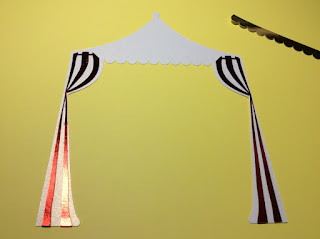Thursday, May 25, 2023
Zigzag Circus Birthday Card
Monday, May 22, 2023
Circus Diorama Decoration for a Birthday Party
Saturday, May 20, 2023
A STEM Project: Sewing a Cloth Tote Bag Using a Pattern Traced With TurtleStitch
Sewing a cloth tote bag is an easy project using a tote pattern traced in TurtleStitch. I have included a pattern file for an 8 x 8 x 4 inch tote in this blog posting so no programming is necessary unless you want to modify the size. Skip to the next section if you do not want to modify the tote pattern size.
How to Make a Tote Pattern in TurtleStitch Using Silhouette Software
To make a tote pattern in TurtleStitch, set the dimensions of the bag and execute my program. https://www.turtlestitch.org/run#cloud:Username=Elaine&ProjectName=Basic%20Tote%20Pattern There are four pattern pieces to make a basic tote bag. Once executed, the file must be brought into the Silhouette software so that the pattern pieces can be cut with the Silhouette Cameo paper cutting machine.
In TurtleStitch, export the design as a DXF file. Open with the Silhouette software. Resize the pattern using the one inch square as reference.
8 x 8 x 4 Tote - File Section
Saturday, May 13, 2023
The History of Marvin Minski’s Logo
I recently attended a workshop hosted by the Logo Foundation, https://el.media.mit.edu/logo-foundation/, featuring the topic of "Minsky Logo". This workshop paid homage to Marvin Minsky. Marvin Minsky, along with Seymour Papert, and Cynthia Solomon worked together to develop and implement Logo in a classroom environment.
Logo is a graphical programming language where children can instruct a "turtle" to move using a series of simple computer commands. The “turtle” can be either a virtual triangle on the computer screen or a physical device/robot moving across a floor. The movement of the “turtle” follows a path which is analogous to a place in the computer’s memory. When the “turtle” is moved, a trail is recorded. These trails can draw complex shapes and patterns as shown below.
A Minsky Logo Program
Marvin Minsky was one of the founding fathers of artificial intelligence at MIT and his goal was to make computers "think". Seymour Papert, was a student of Jean Piaget in Switzerland where he developed theories of learning and the importance of hands-on discovery and exploration. He believed that technology could provide new ways for children to think. In 1963, Marvin Minsky invited Seymour Papert to join him at MIT to do research in intelligence.
Both Seymour and Marvin believed there was an interconnection of how children think and how to make machines think. They both wrote papers about how to learn, one with children and the other with computers. In conclusion, they realized that their outcomes were exactly the same results.
Logo was created in the late 1960's at the Artificial Intelligence Lab at MIT for children to develop critical thinking and problem solving skills. In doing so, it established computers as a tool for learning.
In 1973, Marvin Minsky built a physical device which he called a "turtle". He named this device/robot a TT2500. TT is supposed to stand for Turtle Terminal and 2500 was their guess as to how much it would cost in retail dollars. It did not have enough memory to run the Logo program because it only had 4K of memory. The 4K memory was sufficient for the TT2500 to be run as a terminal by another computer in the PDP 11 family. The 4K chip was eventually replaced with a 64K chip four years later. Interestingly enough, the new upgraded memory was sufficient to run Logo at the same price as its original memory as the cost of chips decreased significantly over time. While Marvin built the physical machine, his daughter, Margaret designed the circuitry for the text display.
After the construction of the TT2500, it was placed in a 7th grade classroom taught by a mathematics teacher for observation and implementation of learning Logo. It was here that Cynthia Solomon noticed that it was being implemented incorrectly. The students were being taught with rout learning and were not given the time to explore the immense possibilities of Logo. Cynthia took over the class and her influence created an environment were Logo flourished. Today Cynthia is known as the "mother of Logo" because she was the first to nurture and enable students to use Logo successfully. https://www.youtube.com/watch?v=maDzjHIiXZc
In Cynthia's classroom, the TT2500 could move on the floor with the Logo commands that were programmed into the machine. It was placed on butcher paper and lines were drawn with the movement of the turtle. The turtle became a drawing instrument with the addition of a pen.
Today, this early version of Logo can be emulated online because Brian Silverman produced the computer code to execute the Logo commands. https://www.playfulinvention.com/demos/MinskyLogo/ Brian Silverman was involved in Logo almost since the beginning of its development.
Logo commands fd - forward bk - back lt - left rt - right pu - pen up pd - pen down st - show the turtle ht - hide the turtle seth.(set heading) - rotate the turtle in a clockwise direction by a specified angle from its home position. clean - Clears the screen of trails but the turtle remains where it is without moving repeat - repeat 3 [fd 60 rt 120] The square brackets indicate that the enclosed commands are to be executed three times.The TT2500 had a new command called spin because kids love animation. New computer hardware had to be built to accommodate this. This was the era were hardware development needed to be done if you were serious about software development.








































